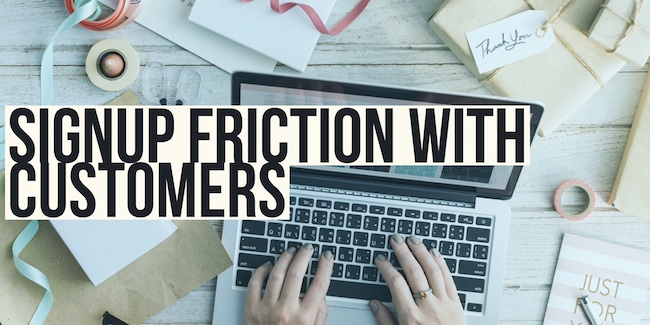We’ve all had negative experiences with trying to sign up for something new, whether it’s a software platform, a department store’s member log-in, or a free sample of paraben-free conditioner. They promise that signing up will only take a few minutes, but you don’t really want to take the time to fill out your name, email address, driver’s license number, shoe size, mother’s favorite flower, and the top five nicknames you call your pet. Before they’ve even had the chance to put us on their mailing list, we’ve already clicked away in annoyance. You don’t want this to happen to your potential customers, clients, or subscribers. Read on to understand a few ways that you can lower your platform signup friction, increase your conversion, and keep new customers happy.
Table of Contents
ToggleDisplay Your Sign-Up Form on the Homepage
Entice your customers to sign up by letting them see just how easy it is to do so. If you bury your sign-up form on another screen, you’re hinting to your customers that it’s not something you want to show them. If it’s the first thing they see, and it has a very, very short number of blank spaces to fill out, they’ll be encouraged by your straightforward, simple sign-up and be more likely to type and click their way into using your service or buying your product.
Use the Foot-In-The-Door Technique
You may want to ask potential customers for their location, the email addresses of several friends, and their credit card information (once it’s on file, it’s that much easier for them to click through and place orders without thinking about it). But giving up a great deal of personal information at once can make your customers nervous. Instead of requiring them to spill the beans as soon as they virtually meet you, ask for information gradually. Start with asking just a couple questions up front; feel free to ask more as you deepen your digital relationship.
Start with the Minimum
What information do you absolutely need up front? Eliminate anything that isn’t essential so that your sign-up form is as short as possible. Consider asking yourself, “What information do I need to make sure that my customers have a good experience?” Then try the opposite question on anything that’s made the cut: “If I didn’t have this piece of information, would I still be able to make sure that my customers have a good experience?” You may be surprised at what you don’t need. You’ll increase your engagement significantly when you reduce decision anxiety and make forms as short and sweet as you reasonably can.
Use Oauth2 Sign-Up
You know when you’re about to sign up for something, when you realize you can just sign up through Facebook? While you’ll still need to offer a traditional email-based signup, Oauth2 is great to help customers avoid forms altogether. Just place these buttons at the top of the form and most people won’t even think; they’ll just click right on through. For those who have privacy concerns about linking together multiple accounts; you’ll still need to make sure that your traditional email signup asks for the bare minimum.















